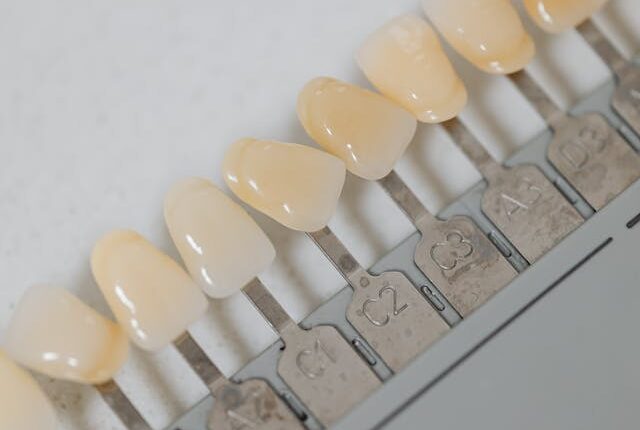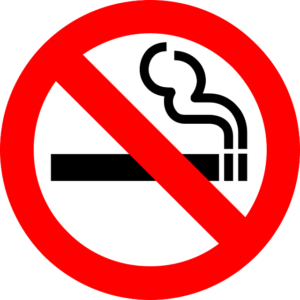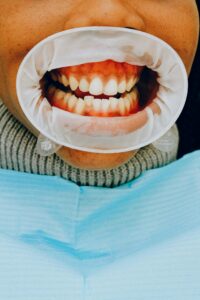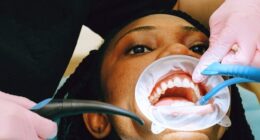Tooth discolouration is a common dental concern that can affect the appearance and confidence of individuals. In this blog post, we’ll delve into the causes of tooth discolouration, strategies for prevention, and treatment options to restore a bright, healthy smile.
Causes of Tooth Discolouration
1. Extrinsic Stains: These stains occur on the outer surface of the tooth (enamel) and are often caused by factors such as:
– Food and Beverages: Dark-coloured foods and drinks like coffee, tea, red wine, berries, and sauces can stain teeth over time.
– Tobacco Use: Smoking or chewing tobacco can lead to yellow or brown stains on teeth due to tar and nicotine deposits.
– Poor Oral Hygiene: Inadequate brushing, flossing, and dental cleanings can allow plaque and tartar buildup, leading to discolouration.
2. Intrinsic Discolouration: These stains originate within the tooth structure (dentin) and may result from:
– Dental Trauma: Injuries, falls, or accidents can cause internal bleeding, nerve damage, or tooth discolouration.
– Dental Fluorosis: Excessive fluoride intake during tooth development (e.g., from fluoridated water, supplements) can lead to white or brown spots on teeth.
– Ageing: As we age, the enamel thins, exposing the yellowish dentin layer underneath, leading to natural discolouration.
3. Medical Factors: Certain medical conditions, medications, or treatments can contribute to tooth discolouration:
– Antibiotics: Prolonged use of antibiotics like tetracycline during childhood can cause greyish or brownish stains on developing teeth.
– Chemotherapy/Radiation: Cancer treatments can affect tooth enamel, leading to discolouration and increased susceptibility to decay.
– Genetics: Some individuals may inherit genes that predispose them to tooth discolouration or enamel defects.
Prevention of Tooth Discolouration
1. Maintain Good Oral Hygiene: Brush your teeth at least twice a day with fluoride toothpaste, floss daily, and visit your dentist regularly for professional cleanings to remove surface stains and plaque buildup.
2. Limit Staining Foods and Drinks: Reduce consumption of dark-coloured beverages (coffee, tea, cola), acidic foods, and sugary snacks that can contribute to tooth discolouration.
3. Quit Smoking: If you smoke or use tobacco products, quitting can prevent yellowing and staining of teeth caused by tobacco tar and nicotine.
4. Use a Straw: When drinking staining beverages, use a straw to minimise contact with tooth surfaces and reduce discolouration.
5. Drink Water and Chew Gum: Rinse your mouth with water after consuming staining foods/drinks, and chew sugar-free gum to stimulate saliva production and neutralise acids.
6. Professional Teeth Whitening: Consider professional teeth whitening treatments provided by dental professionals for the safe and effective removal of surface stains and brightening of discoloured teeth.
7. Protect Teeth During Sports: Wear mouth guards during sports activities to prevent dental injuries, fractures, or trauma that can lead to discolouration.
Treatment Options for Tooth Discolouration
1. Professional Teeth Whitening: In-office teeth whitening procedures involve the application of bleaching agents (hydrogen peroxide or carbamide peroxide) to lighten discolouration and brighten teeth.
2. At-Home Whitening Kits: Dentist-prescribed take-home whitening kits include custom-fitted trays and bleaching gels for gradual whitening of teeth over several weeks.
3. Dental Bonding: Dental bonding uses tooth-coloured resin materials to cover discolouration, chips, or minor imperfections and improve the appearance of teeth.
4. Veneers: Porcelain or composite veneers are custom-made shells placed over the front surface of teeth to conceal discolouration, gaps, or irregularities and create a natural-looking smile.
5. Crowns or Caps: For severe discolouration, damaged enamel, or large fillings, dental crowns or caps may be recommended to restore the shape, function, and aesthetics of teeth.

Tooth discolouration can have various causes, from lifestyle factors and dietary habits to medical conditions and genetic predispositions. By practising good oral hygiene, making healthy dietary choices, quitting tobacco use, and seeking professional dental care, individuals can prevent and address tooth discolouration effectively. Consult with your dentist to determine the underlying cause of discolouration and explore suitable treatment options for achieving a brighter, more confident smile.











